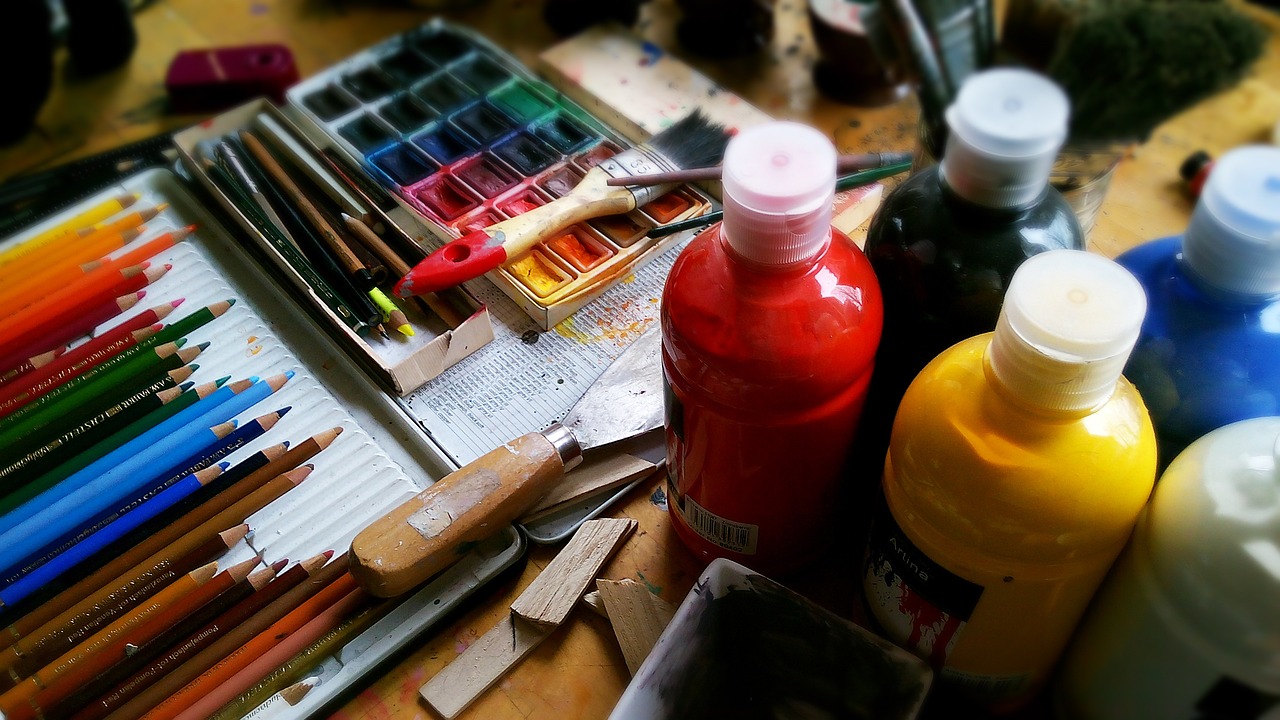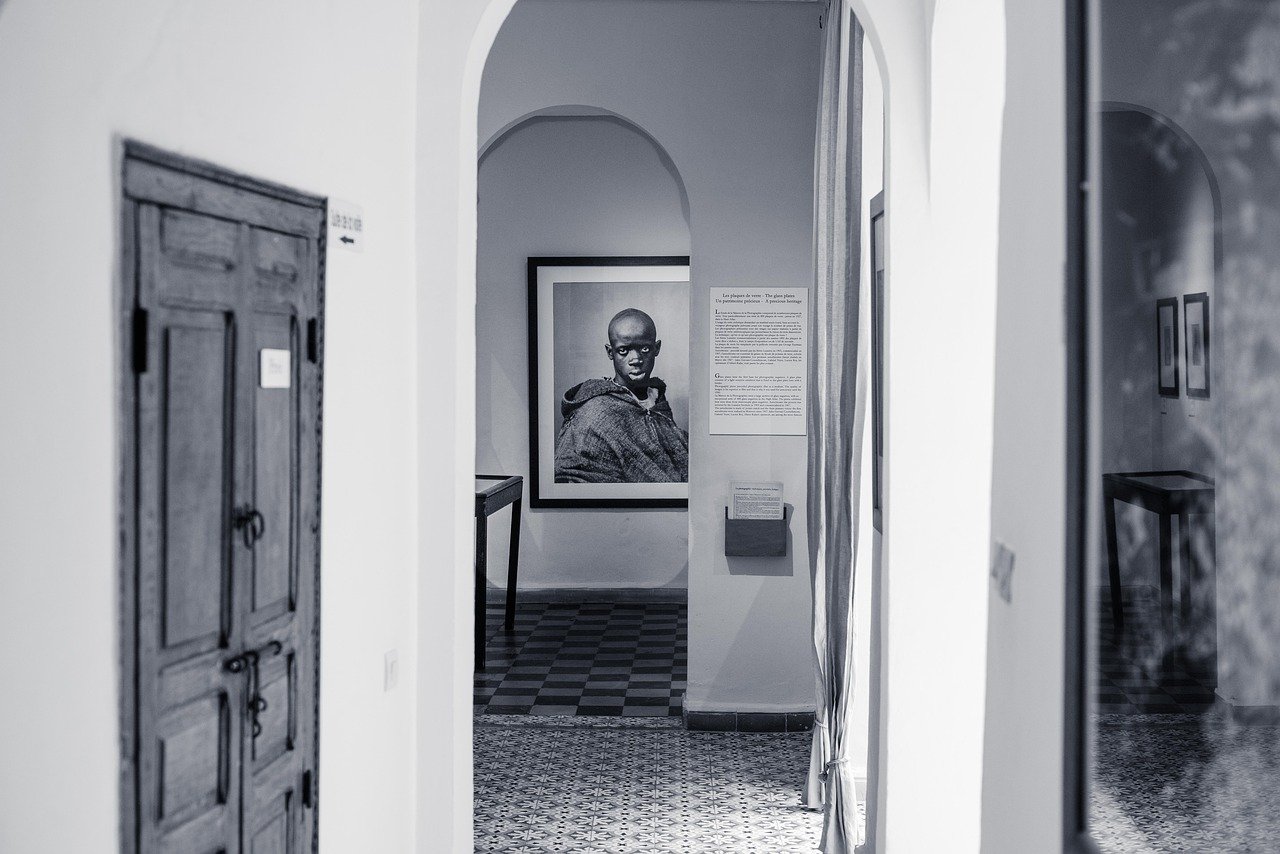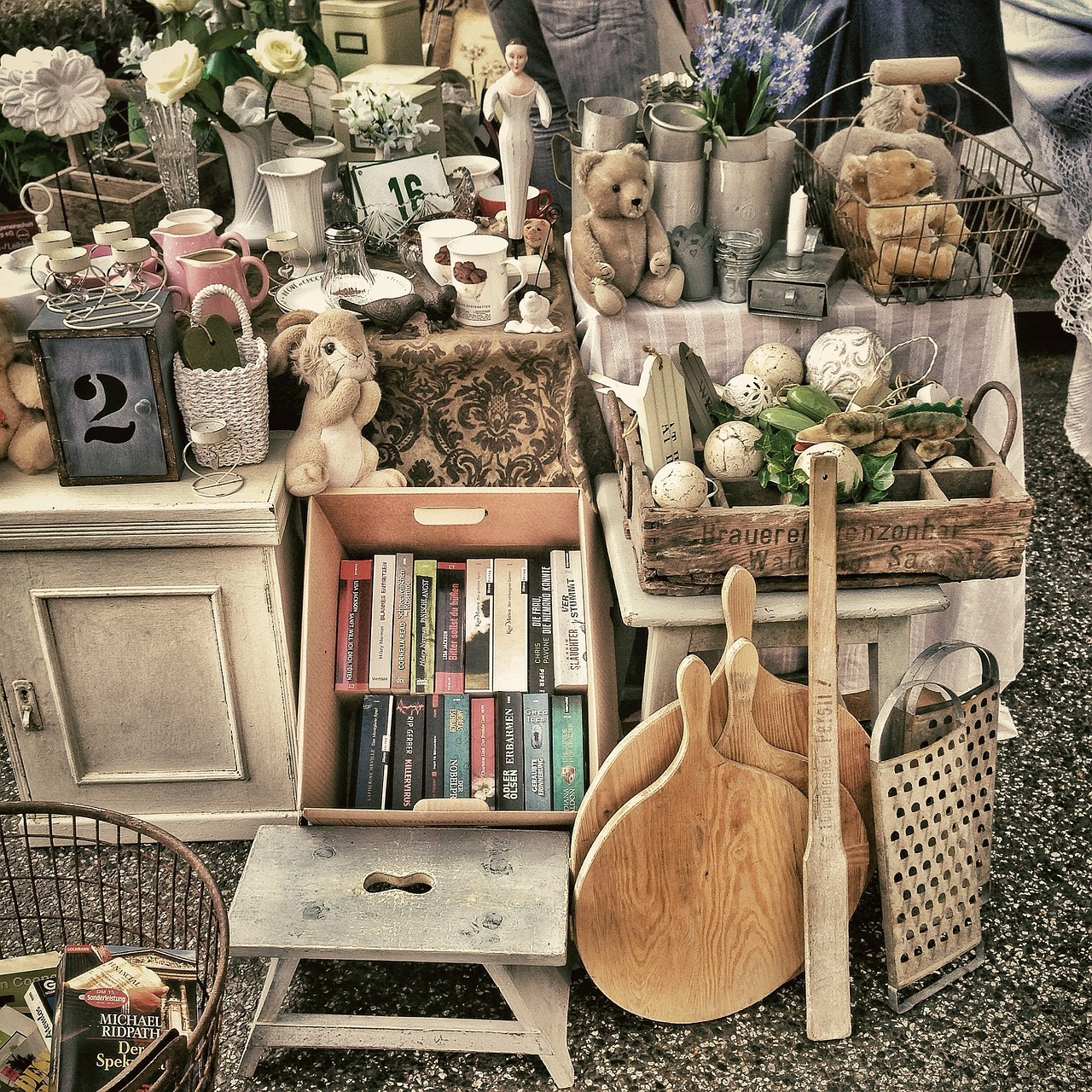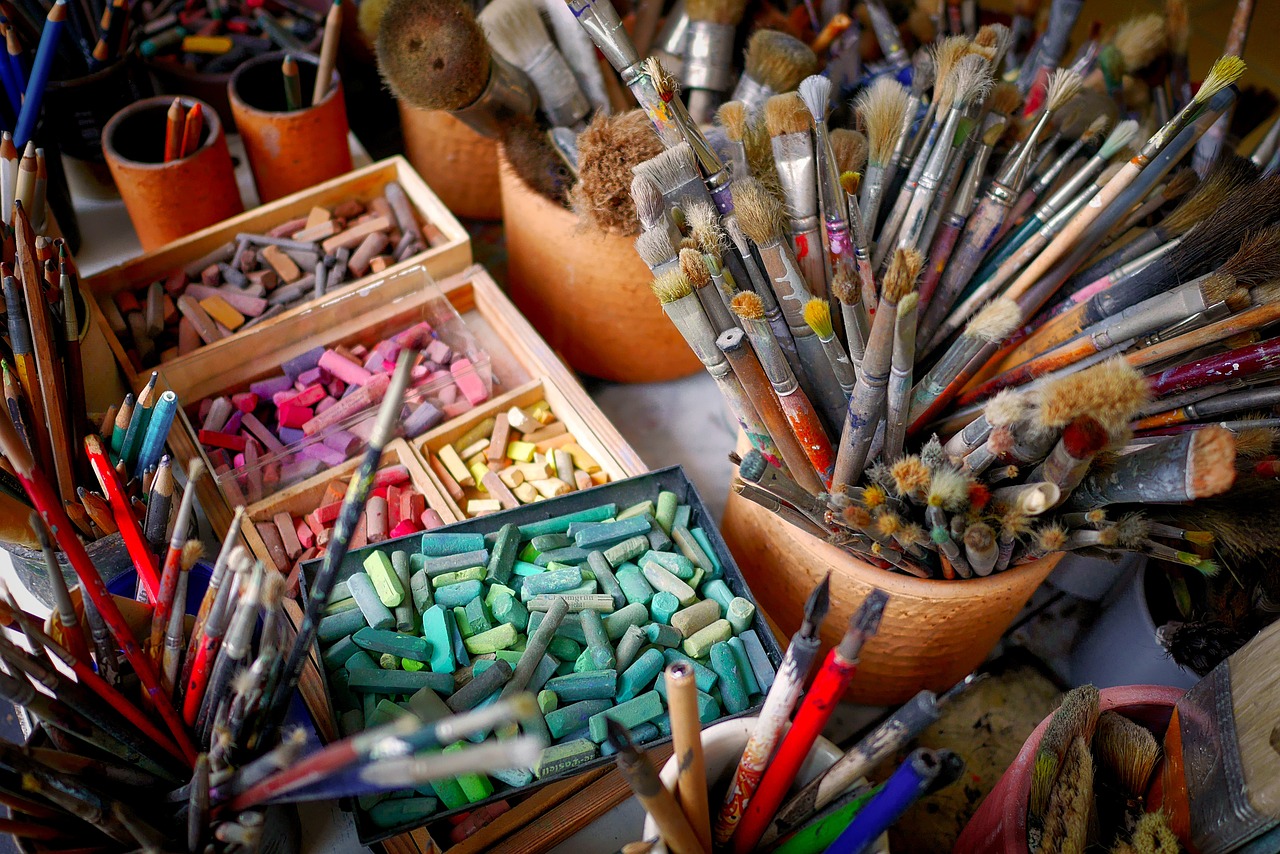How to Break into the Art Market: Selling Your Paintings
Breaking into the art market can feel like trying to navigate a maze without a map. It’s a vibrant, yet complex world where talent meets opportunity, and understanding how to position yourself is crucial. As an emerging artist, you might be wondering, "Where do I even start?" The good news is that with the right strategies, you can successfully enter this exciting market and start selling your paintings. In this guide, we will explore effective techniques for marketing your art, building a compelling portfolio, networking with industry professionals, and understanding pricing structures that can help you thrive.
The art market is a dynamic ecosystem influenced by various factors including trends, buyer behavior, and economic conditions. To successfully sell your paintings, it’s essential to understand these dynamics. For instance, art buyers often seek pieces that resonate with their personal experiences or aesthetic preferences. Keeping an eye on current trends can help you align your work with what’s popular, but remember, authenticity is key. You want your art to reflect your unique voice while still appealing to potential buyers.
Additionally, the art market is divided into several sectors, including contemporary art, fine art, and digital art. Each sector has its own audience and selling strategies. By identifying which sector your work fits into, you can tailor your approach to reach the right buyers. For example, if your work is more contemporary, consider platforms and galleries that specialize in modern art. Understanding these nuances can significantly impact your selling strategy and success.
Your portfolio is your calling card in the art world. It’s not just a collection of your works; it’s a showcase of your artistic journey and vision. A well-curated portfolio can make a lasting impression on potential buyers and galleries. So, how do you create one that stands out? Start by selecting pieces that truly represent your style and skill. Aim for a cohesive look that tells a story about your artistic evolution.
When choosing which pieces to include in your portfolio, think about what best reflects your artistic vision. Consider the following tips:
- Quality over Quantity: It’s better to have a smaller number of exceptional works than a large collection of mediocre ones.
- Variety: Showcase different styles or techniques to demonstrate your versatility, but ensure they still connect under a common theme.
- Audience Appeal: Think about what resonates with your target audience. What do they want to see? What stories do they want to connect with?
Once you have your selected works, the next step is presentation. How you display your art can significantly impact its perceived value. Consider these techniques:
- Framing: A well-chosen frame can enhance your artwork’s visual appeal and make it more marketable.
- Lighting: Proper lighting can bring out the colors and details in your paintings, making them more inviting.
- Digital Formats: In today’s digital age, having high-quality images of your work online is essential. Invest in professional photography to capture your art in the best light.
In the era of digital communication, maintaining both an online and a physical portfolio can be beneficial. An online portfolio allows you to reach a broader audience and adapt to different selling environments. However, a physical portfolio can create a more personal connection during in-person meetings or exhibitions. Weigh the pros and cons of each format:
| Format | Pros | Cons |
|---|---|---|
| Online Portfolio | Wider reach, easily shareable, cost-effective | May lack personal touch, requires tech skills |
| Physical Portfolio | Personal connection, tangible experience | Limited reach, can be costly to produce |
Networking is crucial for artists. Building relationships with other artists, galleries, and collectors can open doors to valuable opportunities. Attend local art events, join online forums, and participate in workshops to meet like-minded individuals. Remember, every connection can lead to a new opportunity, whether it’s a collaboration or a chance to showcase your work in a gallery. Don't underestimate the power of a simple conversation; it could be the key to your next sale.
Effective marketing strategies are essential for success in the art market. With a myriad of channels available, it’s important to discover which ones resonate with your audience. Social media platforms like Instagram and Pinterest are fantastic for visual artists to showcase their work and engage with followers. Regularly posting updates on your art journey, behind-the-scenes processes, and completed works can help build a loyal community around your artistic brand.
Social media isn’t just a tool; it's a powerful platform for artists. It allows you to showcase your artwork, engage with followers, and even sell directly to buyers. By sharing your artistic process, you create a narrative that followers can connect with, making them more likely to support your work. Utilize hashtags, engage with your community, and don’t shy away from showing your personality!
Participating in local and national art shows can provide exposure and networking opportunities that are invaluable for emerging artists. Not only do these events allow you to display your work, but they also give you the chance to meet potential buyers face-to-face. Plus, selling your work directly to buyers can be incredibly fulfilling and rewarding.
1. How do I price my paintings?
Pricing your artwork can be tricky. Consider factors such as your materials, time spent, and the market demand. Research similar works to gauge what buyers are willing to pay.
2. Should I sell my art online or in galleries?
Both options have their benefits. Selling online can reach a wider audience, while galleries can provide credibility and a personal touch. Consider what aligns best with your goals.
3. How can I improve my chances of selling my art?
Focus on building your portfolio, networking, and marketing your art effectively. The more visible you are, the better your chances of making sales.

Understanding the Art Market
The art market is a vibrant and ever-evolving landscape that can feel overwhelming, especially for emerging artists. To successfully navigate this world, it’s crucial to understand its dynamics. The art market is not just about selling paintings; it encompasses a variety of sectors, including galleries, auctions, and online platforms. Each of these sectors has its own unique trends and buyer behaviors that can significantly impact your selling strategy.
One of the first things to grasp is that the art market is influenced by trends that can shift rapidly. For instance, certain art styles may gain popularity due to cultural movements or social media influences. As an artist, staying informed about these trends can help you align your work with what buyers are currently seeking. But don’t just follow the crowd; your unique style is what sets you apart. Think of the art market as a vast ocean, where each wave represents a different trend. You want to ride the right wave without losing your own artistic identity.
Understanding buyer behavior is another key element. Buyers are not just looking for pretty pictures; they are often seeking a connection to the artwork and the artist behind it. They want to know the story, the inspiration, and the emotion behind each piece. This is where your personal narrative comes into play. Share your journey as an artist, your creative process, and what drives you. This connection can turn casual observers into passionate collectors.
Moreover, the art market is divided into several sectors, each catering to different types of buyers. For example:
- Primary Market: This is where new artists sell their work directly to collectors and galleries.
- Secondary Market: This involves resales of artworks, often through auctions or galleries, where established artists’ works are sold.
- Online Market: A rapidly growing sector where artists can sell directly to consumers through platforms like Etsy, Saatchi Art, or even their own websites.
Each sector has its own nuances and understanding them can help you position your work effectively. For instance, if you’re focusing on the online market, you’ll need to invest time in digital marketing and social media to attract buyers. Conversely, if you’re leaning towards the primary market through galleries, building relationships and networking will be vital.
In conclusion, breaking into the art market requires a blend of understanding its dynamics, aligning your work with current trends, and engaging with potential buyers on a personal level. It's not just about selling a painting; it's about creating an experience and a connection. As you embark on this journey, remember to keep your artistic voice loud and clear amidst the noise of the market.
1. What are the best platforms for selling my art?
There are numerous platforms available, including online marketplaces like Etsy and Saatchi Art, as well as social media platforms like Instagram. Choose the ones that align best with your target audience.
2. How do I price my artwork?
Pricing can be tricky. Consider factors like your experience, the cost of materials, and the time spent on each piece. Research similar works in your genre to find a competitive price point.
3. How can I effectively network in the art community?
Attend local art shows, join online forums, and participate in workshops. Building relationships with other artists and collectors can open doors to new opportunities.

Building Your Portfolio
Creating a compelling portfolio is one of the most crucial steps for any emerging artist looking to make a mark in the art market. Your portfolio is essentially your artistic resume; it showcases your unique style, skills, and vision to potential buyers and galleries. Think of it as your personal gallery that you can carry around or display online. It should not only reflect your best works but also tell a story about who you are as an artist. So, how do you go about building this essential tool?
First and foremost, you need to select the right pieces to include in your portfolio. This is not merely a matter of picking your favorite paintings; it's about curating a collection that resonates with your artistic vision and appeals to your target audience. Consider the following aspects when choosing your works:
- Diversity: Showcase a range of styles, techniques, and themes to demonstrate your versatility.
- Quality Over Quantity: It's better to have a smaller number of high-quality pieces than a large collection of mediocre works.
- Consistency: Ensure that the works you choose reflect a consistent artistic voice, making it easier for viewers to understand your style.
Remember, your portfolio should be a reflection of your artistic journey. So, include pieces that not only highlight your technical skills but also convey your personal story and experiences.
Once you have selected your best works, the next step is to present them effectively. Presentation can make or break the impression your portfolio leaves on potential buyers or galleries. Here are a few techniques to consider:
- Framing: Proper framing can enhance the visual appeal of your artwork. Choose frames that complement your pieces without overshadowing them.
- Lighting: Good lighting is essential when displaying your work in person. Natural light is often the best, but if you're showcasing online, make sure your photographs are well-lit and clear.
- Digital Formats: If you're creating an online portfolio, consider using high-resolution images and interactive elements that allow viewers to engage with your work.
These techniques can help create a lasting impression, making your portfolio not just a collection of works, but an experience for the viewer.
In today's digital age, having both an online and a physical portfolio can significantly expand your reach. Each format has its pros and cons. An online portfolio allows you to showcase your work to a global audience and is easily shareable via social media. On the other hand, a physical portfolio can provide a tactile experience that many buyers appreciate, especially during in-person meetings or art shows.
Consider maintaining a balance between the two. Your online portfolio can serve as a dynamic platform that you update regularly, while your physical portfolio can be curated to showcase your absolute best works for specific events or meetings. This dual approach will allow you to adapt to different selling environments and maximize your opportunities for exposure and sales.
In conclusion, building a portfolio is not just about gathering your art; it’s about crafting a narrative that captures your essence as an artist. By carefully selecting your best works, presenting them effectively, and utilizing both online and physical formats, you can create a portfolio that truly stands out in the competitive art market.
Q: How many pieces should I include in my portfolio?
A: Ideally, aim for 10-15 of your best pieces. This allows you to showcase your versatility without overwhelming the viewer.
Q: Should my portfolio include only finished works?
A: While finished works are essential, including a few sketches or work-in-progress pieces can offer insight into your creative process and evolution as an artist.
Q: How often should I update my portfolio?
A: Regular updates are crucial. Aim to refresh your portfolio every 6-12 months to keep it relevant and reflective of your current style and skills.

Choosing Your Best Works
When it comes to building your portfolio, the selection of your best works is crucial. Think of your portfolio as your personal gallery; it should reflect not just your talent but also your unique artistic voice. So, how do you choose the right pieces? Start by considering the themes and styles that resonate with you the most. Are you drawn to vibrant colors, abstract forms, or perhaps landscapes? Your portfolio should tell a story, showcasing your evolution as an artist.
Next, evaluate your body of work. It’s tempting to include everything you’ve ever created, but remember that quality trumps quantity. Ask yourself: which pieces received the most positive feedback? Which ones are you most proud of? Select works that not only demonstrate your skills but also evoke emotion or provoke thought in the viewer. A well-rounded portfolio often includes:
- Diverse Styles: Show a range of techniques and mediums.
- Signature Pieces: Include works that define your style.
- Recent Works: Highlight your latest creations to show growth.
Furthermore, consider your target audience. If you're aiming to sell to collectors who appreciate contemporary art, choose pieces that align with current trends. Conversely, if your goal is to enter traditional galleries, select works that reflect classic techniques. A good rule of thumb is to have a mix of pieces that not only showcase your versatility but also cater to different tastes.
Once you've shortlisted your works, it’s time to think about presentation. How you frame and display your art can significantly impact its appeal. Invest time in framing your pieces professionally, as this can elevate their perceived value. Additionally, consider the lighting and background when photographing your artwork for digital portfolios. A well-lit, clean image can make a world of difference in how potential buyers perceive your art.
Lastly, don’t hesitate to seek feedback from fellow artists or mentors. They can provide valuable insights that you might overlook. Sometimes, a fresh set of eyes can help you identify which pieces truly stand out. Remember, your portfolio is a living document; it should evolve as your style and skills grow. Regularly reassess your selections to keep your portfolio relevant and reflective of your artistic journey.
| Question | Answer |
|---|---|
| How many pieces should I include in my portfolio? | It's best to include between 10 to 20 pieces that showcase your best work. |
| Should I include older works in my portfolio? | Only if they still represent your style and skills effectively. Focus on your most recent and impactful pieces. |
| How often should I update my portfolio? | Regularly! Aim to reassess and update your portfolio every six months to reflect your latest work and growth. |

Presentation Techniques
When it comes to selling your paintings, presentation is everything. Think of your artwork as a beautiful gift wrapped in the finest paper; the wrapping enhances the value and appeal of the gift within. The way you present your art can make a significant difference in how potential buyers perceive its worth. So, what are some effective presentation techniques that can help your artwork shine?
First and foremost, consider framing. The right frame can elevate your painting, drawing attention to its colors and details. A well-chosen frame complements the artwork, creating a cohesive look that invites viewers to engage. For instance, a modern piece might benefit from a sleek, minimalist frame, while a traditional landscape may look stunning in an ornate, vintage frame. Don't underestimate the power of a good frame; it can transform a good piece into a great one.
Next, let’s talk about lighting. Proper lighting can make or break the viewing experience. Imagine walking into a gallery where the art is dimly lit; it feels uninviting, doesn’t it? Instead, aim for lighting that highlights your work without overwhelming it. Natural light is often the best option, but if that's not available, consider using spotlights or LED lights that can enhance the colors and textures of your paintings. Experiment with different angles and intensities to find what works best for each piece.
Another important element is the use of digital formats. In today's digital age, having an online presence is crucial. Consider creating high-quality images of your artwork and presenting them in an engaging digital portfolio. This allows you to reach a wider audience and showcase your work in various settings. Additionally, don't forget to optimize these images for social media and online galleries; the more appealing they look, the more likely they are to attract potential buyers.
In addition to framing, lighting, and digital presentation, think about the overall layout of your exhibition space. Whether you’re displaying your work in a gallery or at home, the arrangement of your pieces can influence how they are perceived. Grouping similar works together can create a narrative, guiding viewers through your artistic journey. Alternatively, spacing out your pieces allows each one to stand alone, giving viewers the chance to appreciate them individually.
Lastly, consider adding an element of storytelling to your presentation. People love to connect with art on a personal level. Share the inspiration behind each piece, or the techniques you used to create it. This not only adds depth to the viewing experience but also helps potential buyers feel more connected to your work. After all, art is not just about aesthetics; it’s about the emotions and stories that resonate with us.
In summary, effective presentation techniques can significantly enhance the appeal of your artwork. By focusing on framing, lighting, digital formats, layout, and storytelling, you can create a memorable experience for potential buyers that not only showcases your talent but also elevates the perceived value of your paintings.
- What is the best type of frame for my paintings?
It depends on your artwork's style. Modern pieces often look best in sleek frames, while traditional works may benefit from ornate designs. - How can I improve the lighting for my artwork?
Natural light is ideal, but you can also use adjustable LED lights to highlight your work effectively. - Is it necessary to have a digital portfolio?
Yes, a digital portfolio allows you to reach a wider audience and showcase your work in various online platforms. - How can I create a narrative with my artwork?
Group similar works together and provide background stories for each piece to guide viewers through your artistic journey.

Online vs. Physical Portfolios
When it comes to showcasing your artwork, the debate between online and physical portfolios is a hot topic among artists. Each format has its own unique advantages and challenges, and the choice ultimately depends on your personal style and goals. Let’s dive into the nitty-gritty of both options to help you make an informed decision.
Starting with the online portfolio, there’s no denying the sheer reach it offers. With just a few clicks, your artwork can be viewed by potential buyers, galleries, and fellow artists from around the globe. Imagine your painting being discovered by someone in another country, leading to a sale you never thought possible! Plus, maintaining an online portfolio is often more cost-effective than printing and framing physical pieces. You can easily update your website or social media profiles with new works, keeping your audience engaged and excited about your latest creations.
However, the online world can be overwhelming and saturated with competition. It’s essential to stand out amidst the sea of talent, which can sometimes feel like shouting into a void. You’ll need to invest time in SEO strategies and social media marketing to ensure your work gets noticed. It’s not enough to just upload images; you must actively engage with your audience and promote your art to drive traffic to your portfolio.
On the flip side, a physical portfolio offers a tactile experience that online platforms simply can’t replicate. When potential buyers or gallery owners flip through a beautifully arranged physical portfolio, they can appreciate the texture, colors, and intricacies of your work in a way that digital images may not convey. There’s something special about the in-person interaction that can create a lasting impression. Additionally, physical portfolios can be a powerful tool for networking events or art shows, allowing you to have a direct conversation about your artwork while showcasing it in real-time.
However, physical portfolios come with their own set of challenges. They can be costly to produce, especially if you’re printing high-quality images and investing in professional presentation materials. Additionally, they limit your reach; unless you’re actively attending events or meetings, your artwork is confined to a specific location. This makes it crucial to balance both formats to maximize your visibility.
In conclusion, the choice between online and physical portfolios isn’t a matter of one being better than the other; rather, it’s about finding the right balance that works for you. Many successful artists use a combination of both to cater to different audiences and situations. By leveraging the strengths of each format, you can create a comprehensive presentation of your work that appeals to a wider range of potential buyers.
- Can I have both an online and physical portfolio? Absolutely! Many artists find that having both allows them to reach different audiences and showcase their work in various settings.
- How often should I update my online portfolio? Regular updates are key to keeping your audience engaged. Aim to refresh your portfolio every few months or whenever you create new work.
- What should I include in my physical portfolio? Include a variety of your best work, artist statements, and any relevant awards or exhibitions to give potential buyers a comprehensive view of your artistic journey.

Networking in the Art Community
Networking is like the lifeblood of the art community; it’s essential for artists looking to make their mark. Just think about it: how do you expect to sell your beautiful paintings if no one knows who you are? Building relationships with other artists, galleries, and collectors can open doors that you didn’t even know existed! It’s not just about handing out business cards; it’s about creating genuine connections that can lead to exciting opportunities.
One of the best ways to start networking is by attending local art events. Whether it’s gallery openings, art fairs, or workshops, these gatherings are filled with people who share your passion. You might bump into a seasoned artist who can offer invaluable advice or a gallery owner looking for fresh talent. The key here is to be approachable and ready to share your story. Don’t be shy about talking about your art; after all, it’s a huge part of who you are!
Social media has also revolutionized how artists connect. Platforms like Instagram and Pinterest are fantastic for showcasing your work and engaging with a broader audience. You can follow other artists, comment on their work, and even collaborate on projects. Creating a vibrant online presence not only helps you get noticed, but it also allows you to join conversations about art trends, techniques, and exhibitions. Remember, every comment or like can lead to a new follower, and who knows? That follower might be your next collector!
Besides online interactions, consider joining art organizations or collectives. These groups often host events, workshops, and exhibitions that can help you gain exposure. Plus, being part of a community can provide you with support and encouragement from fellow artists who understand the ups and downs of the creative journey. It's like having a built-in cheerleading squad!
When networking, always keep in mind the importance of reciprocity. Building relationships is a two-way street; offer your support to others, whether it’s promoting their work on social media or providing constructive feedback. This not only strengthens your connections but also builds your reputation as a generous and engaged member of the art community.
In conclusion, networking in the art community is not just about making connections; it’s about fostering relationships that can lead to growth, opportunities, and success. So get out there, engage with others, and watch your artistic journey unfold!
- How do I start networking in the art community? Begin by attending local art events, joining online art groups, and actively engaging on social media platforms.
- What should I say when meeting other artists? Share your artistic journey, ask about their work, and express genuine interest in their projects.
- Are online connections as valuable as in-person ones? Absolutely! Online networking can lead to collaborations, exhibitions, and sales opportunities just like in-person connections.
- How can I maintain relationships with my contacts? Regularly engage with them through social media, attend their exhibitions, and check in occasionally to see how they’re doing.

Marketing Your Art
Effective marketing strategies are the lifeblood of any artist looking to make a name for themselves in the competitive art market. It's not just about creating beautiful paintings; it’s about ensuring that your art reaches the eyes of potential buyers. Imagine your artwork as a treasure buried in the sand—without a map, how will anyone ever find it? The right marketing techniques can serve as that map, guiding art lovers straight to your creations.
One of the most powerful tools at your disposal is social media. Platforms like Instagram, Facebook, and Pinterest are not just for sharing personal moments; they are vibrant galleries where artists can showcase their work to a global audience. By posting high-quality images of your paintings, engaging with followers, and using relevant hashtags, you can significantly increase your visibility. Think of it as throwing a party; the more enticing your invitation, the more guests will show up. Social media allows you to create that enticing invitation, drawing in art enthusiasts who may want to purchase your work.
But the digital world isn't the only place to market your art. Participating in local and national art shows can provide invaluable exposure. These events are like bustling marketplaces where artists and collectors converge, creating a dynamic environment for networking and sales. When you showcase your work in person, you not only attract potential buyers but also get to connect with other artists and galleries. It’s a golden opportunity to share your story, explain your artistic process, and make lasting impressions. Just like a live concert, the energy and excitement of being in the same space as your audience can create a memorable experience that resonates long after the event is over.
To maximize your marketing efforts, consider creating a marketing plan that outlines your goals, target audience, and the specific channels you want to utilize. A simple table can help you visualize your strategy:
| Marketing Channel | Objective | Frequency |
|---|---|---|
| Social Media | Showcase artwork and engage followers | Daily |
| Art Shows | Network and sell directly | Monthly |
| Email Newsletter | Update followers on new works and events | Bi-weekly |
| Website | Display portfolio and facilitate sales | Ongoing |
In addition to these channels, consider building an email list. This allows you to communicate directly with interested buyers, keeping them updated on new artworks, exhibitions, and special promotions. Just like a personal letter, emails can create a sense of intimacy and connection, making your audience feel valued and more likely to support your work.
Lastly, don’t underestimate the power of word-of-mouth marketing. Encourage satisfied customers to share their experiences and recommend your art to friends and family. You could even offer incentives for referrals, creating a win-win situation. Remember, every conversation is an opportunity to spread the word about your art, so don't shy away from discussing your passion whenever you can.
In essence, marketing your art is about creating a buzz around your work. Whether through social media, art shows, or personal connections, your goal is to make your art as accessible as possible to those who will appreciate it. So, roll up your sleeves, get creative with your marketing strategies, and watch your art journey take flight!
- What is the best social media platform for artists? Instagram is widely regarded as the best platform for visual artists due to its focus on images.
- How often should I post my artwork online? Aim for at least once a day to keep your audience engaged without overwhelming them.
- Are art shows worth the investment? Yes, they can provide exposure and networking opportunities that lead to sales.

Utilizing Social Media
In today’s digital age, social media is not just a platform for sharing selfies or cat videos; it has become an essential tool for artists looking to break into the art market. Imagine being able to showcase your artwork to thousands of potential buyers with just a few clicks. Sounds like a dream, right? Well, it’s entirely possible! By harnessing the power of platforms like Instagram, Facebook, and Pinterest, you can create a vibrant online presence that attracts attention and drives sales.
First things first, let’s talk about Instagram. This visually-driven platform is perfect for artists. With its focus on images, you can post high-quality photos of your paintings, share behind-the-scenes processes, and even create engaging stories that connect with your audience on a personal level. Have you ever thought about using Instagram Stories to give your followers a sneak peek into your creative process? This not only builds anticipation for your upcoming works but also humanizes your brand, making it relatable and engaging.
Next up is Facebook. While it may not be as visually focused as Instagram, it offers unique opportunities for interaction. You can join art groups, participate in discussions, and even create events for your exhibitions. Plus, Facebook Ads can be a game-changer. With targeted advertising, you can reach specific demographics that are most likely to be interested in your art. Imagine being able to show your work to art collectors in your area or even across the globe!
Don’t overlook Pinterest, either. This platform is often underestimated by artists, but it can be a treasure trove for driving traffic to your website or online shop. By creating boards that showcase your artwork, you can reach an audience that is actively seeking inspiration and ideas. Think of Pinterest as a digital scrapbook where your art can shine and be shared by others, potentially leading to sales and commissions.
When utilizing social media, consistency is key. Regularly posting content keeps your audience engaged and interested in your work. You can create a content calendar to help plan and schedule your posts. This way, you can ensure a mix of promotional posts, personal stories, and engaging questions that encourage interaction. Remember, the goal is to build a community around your art, not just a customer base.
Finally, always engage with your audience. Respond to comments, ask for feedback, and create conversations around your art. This engagement not only fosters a loyal following but also helps you understand what resonates with your audience. After all, art is about connection, and social media provides a fantastic platform to create those connections.
In summary, utilizing social media effectively can be a powerful strategy for emerging artists. By showcasing your work, engaging with your audience, and leveraging the unique features of each platform, you can significantly increase your visibility in the art market. So, are you ready to take your art to the next level? Start posting, sharing, and connecting today!
- How often should I post on social media? It's recommended to post at least 3-5 times a week to keep your audience engaged.
- Which social media platform is best for artists? Instagram is often considered the best due to its visual nature, but Facebook and Pinterest also have their unique advantages.
- Should I use hashtags? Yes! Hashtags can help increase the visibility of your posts and attract new followers interested in your art.

Participating in Art Shows
Participating in art shows can be a game-changer for emerging artists looking to make their mark in the art world. Imagine stepping into a vibrant space filled with creativity, where your work can be showcased alongside other talented artists. It’s not just about selling your paintings; it’s about building connections, gaining visibility, and immersing yourself in the art community. So, how do you make the most of these opportunities? Let's dive into some key benefits and strategies!
First and foremost, art shows provide an invaluable platform for exposure. When you display your work in a well-attended exhibition, you’re not just showing your paintings; you're inviting potential buyers, collectors, and even gallery owners to experience your art firsthand. The tactile nature of art is something that digital platforms can't fully replicate. Being able to see and feel the texture, color, and emotion in person can lead to deeper connections with your audience.
Moreover, art shows often attract a diverse crowd. You might encounter seasoned collectors looking for their next investment, casual art enthusiasts, or even fellow artists seeking collaboration opportunities. Each interaction can open doors to new possibilities, whether that means selling a piece, receiving commissions, or simply gaining feedback that can help you grow as an artist.
However, it’s essential to approach art shows with a strategic mindset. Here are some tips to maximize your experience:
- Research the Show: Understand the theme, audience, and reputation of the art show. This will help you tailor your work and presentation to fit the event.
- Prepare Your Artwork: Ensure that your pieces are professionally framed and ready for display. Presentation matters, so consider how your work will look in the space provided.
- Engage with Visitors: Be approachable and ready to discuss your work. Share your artistic process and the stories behind your pieces. This personal touch can resonate with potential buyers.
Additionally, consider participating in a variety of shows, from local community events to larger national exhibitions. Each experience will teach you something new and help you refine your approach. Keep in mind that not every art show will yield immediate sales, but the long-term benefits of networking and exposure can be worth the investment.
Finally, after the show, don’t forget to follow up with the contacts you made. Whether it's through social media or email, maintaining these connections can lead to future opportunities. Remember, the art world thrives on relationships, and every interaction can be the start of something incredible.
Q: How do I find art shows to participate in?
A: You can search online for local galleries, art associations, and community centers that host exhibitions. Websites like Eventbrite and local art groups on social media can also provide leads.
Q: What should I bring to an art show?
A: Bring your artwork, business cards, a portfolio, and any promotional materials. Don’t forget a positive attitude and a willingness to engage with attendees!
Q: Do I need to pay to participate in an art show?
A: Many art shows require an entry fee or a percentage of sales. Be sure to read the application guidelines carefully to understand any costs involved.
Q: What if I don’t sell anything at the show?
A: That’s okay! Focus on the connections you made and the exposure you gained. Every show is a learning experience that can help you improve for future events.
Frequently Asked Questions
- What is the best way to understand the art market?
To truly grasp the art market, it's essential to research current trends, buyer behavior, and the different sectors within the industry. Dive into art magazines, attend exhibitions, and follow influential art blogs to keep your finger on the pulse.
- How do I build a compelling portfolio?
Your portfolio should be a reflection of your unique style and skills. Select your best works that not only showcase your talent but also resonate with your target audience. Remember, quality over quantity is key!
- What should I consider when choosing artworks for my portfolio?
Choose pieces that highlight your artistic vision and demonstrate a range of techniques. Think about what will appeal to galleries and buyers alike. It's like curating a mini-exhibition of your best self!
- How can I effectively present my artwork?
Presentation is everything! Consider framing your pieces well, using proper lighting, and even experimenting with digital formats. The goal is to create a visual experience that leaves a lasting impression.
- Should I have an online portfolio or a physical one?
Both have their advantages! An online portfolio allows you to reach a wider audience, while a physical portfolio can create a personal connection during in-person meetings. Why not have the best of both worlds?
- How important is networking in the art community?
Networking is crucial! Building relationships with other artists, galleries, and collectors can open doors to sales opportunities and collaborations. Think of it as planting seeds for future growth!
- What marketing strategies should I use to promote my art?
Utilize social media platforms to showcase your work and engage with your audience. Additionally, consider participating in art shows to gain exposure and connect with potential buyers directly.
- How can social media help me sell my paintings?
Social media is a powerful tool for artists. It allows you to share your artwork, tell your story, and interact with followers. Building a loyal community can significantly boost your visibility and sales!
- What are the benefits of participating in art shows?
Art shows provide fantastic opportunities for exposure and networking. They allow you to showcase your work to a live audience and potentially sell directly to buyers, creating a buzz around your art!



















